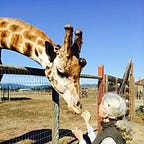Scaffolding: Helping to Support a New Paradigm in its Becoming
When we think of scaffolds, our minds almost always go to the steel pipe structures that surround buildings as they are being constructed to provide handholds and footholds so construction workers can work safely. As a teacher and mentor, scaffolding doesn’t mean literally constructing planks and poles against the side of a building. Rather it as a way of providing students with temporary, supportive structures that, just like in construction, are gradually removed as the building nears completion.
Scaffolds are enablers, facilitating something to occur because it offers a support system to something else. I remember when my son was just learning to walk, I was in the kitchen when I heard these tiny footsteps coming my way. I turned and looked down and there he was with a huge smile on his face. He clasped a clothespin with his hand, as if it was the familiar finger of an adult. He used the clothespin for a few more days then left it behind as his confidence grew in his own abilities to support himself. The website ELLS offers three types of learning scaffolds: Sensory, interactive, and graphical. Each in their own way support ongoing learning until the student reaches a point where these tools can fall away.
I think of scaffolding as enablers for all kinds of learning. Workshops for instance are a scaffolding offering processes and tools to become competent at some skill or task. Schools are scaffolds for learners. The entire university system, at its best, serves as scaffolding for helping students become well rounded social beings. They are meant to help students to grow and develop through the early stages of adulthood.
The MG Taylor process and method employs scaffolds to provide people with a a safe place to play with, and try out new, sometimes crazy ideas, and to decide together how to realize them without compromise.
In my way of thinking, the coronavirus is a scaffold, providing a foothold from which we can see the consequences of our actions on Earth that were obscure, if not invisible, before the virus arrived. For years, a growing population of visionaries have been talking about human ignorance in regards to the stewardship needed to care for Earth. Yet the pace of change has been slow, hesitant, difficult to make a case for. We could talk about, build models and develop theories that played “What ifs” and “Now whats” but conversations were too ethereal, too invisible to build much agreement or energy around.
Coronavirus sent us to our homes to shelter in place, to separate ourselves from one another. Within several weeks of this isolation, skies became bluer, and air cleaner revealing skies and mountain tops that had not been seen for years. People began revealing their better selves, realizing they cared for each other after all. This slowing down provided time and space to reveal how much we had in common, an entire world sheltering in place, isolated, separated from one another and nature.
The virus provides a scaffold of time and distance. It gives us a way to measure and see differences that before we could only talk about, argue about. Every night on our TVs, instead of massive amounts of violence and dystopia, stories of coronavirus heroics are featured. We learn of first responders, ordinary citizens stepping up throughout the world to offer love and care. We witness communities and neighborhoods, getting back in touch with each other celebrating small things. We find remarkable ways to stay in touch while being separated from each other.
Perhaps most of all, the coronavirus pandemic has revealed the systemic relationships that we have talked about for years, but have not been able to see so clearly. This little invisible virus has brought education, economics, and our social norms to their knees. We now know first hand, a world of intertwined relationships, and how one event can change how we see, feel, learn, and adapt. Now, perhaps for the first time, we see that single mindedness can work against us. Citizens — and even politicians — from all facets of life and backgrounds are asking new questions, seeing new opportunities to learn, adapt, and perhaps most importantly see differently about where and how to take creative steps toward, radically new economies.
Today the world is different from what it was just a few months ago. We have crumbled human ecosystems revealing our weak and faulty assumptions about power, money, wealth, happiness and who matters. Coronavirus has shaken our beliefs to the core. In what I call the Great Pause, life has become more sacred, our minds have opened to creativity and inspiration. Solutions never thought of, or appreciated have come front and center. We the people are stepping up as individuals and communities not waiting for politics to click in. We are gifting each other in unprecedented ways. Another world is showing up, enabling us to see a better world, with more equity and love. Exemplars everywhere are guiding, providing new ways to see both ourselves and Earth and the harmony that we can reach for.
We are the framers and architects of a new paradigm in the making. As we rebuild and recreate, what scaffolds will we put in place to help us transform from one paradigm to another? One that brings forth a better, healthier world with a deep and new understanding of our interrelational nature? One that can work for all life on earth? What have we realized that we can no longer do without and what are we willing to let go of?
What we see changes who we become and what we find and make known with each other will not only change who we become, but what the world becomes.
